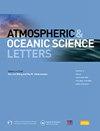Impact of the Changbai Mountains’ topography on spring fog over the Bohai Sea
IF 3.2
4区 地球科学
Q3 METEOROLOGY & ATMOSPHERIC SCIENCES
引用次数: 0
Abstract
Fog is a highly complex weather phenomenon influenced by numerous factors. This study investigated the impact of the Changbai Mountains’ topography on the formation and development of spring fog in the Bohai Sea. From 12 to 14 May 2021, the Bohai region experienced a sea fog event. Utilizing Himawari-8 satellite data, ERA5 reanalysis dataset, land and sea station observations, the WRF model, a topography sensitivity experiment, and backward trajectory tracking, the influence of the Changbai Mountains’ topography on the evolution of this sea fog event was assessed. Results indicated that the Changbai Mountains’ topography significantly impacted the propagation and concentration of the sea fog through dual effects—namely, the Venturi Effect and Foehn Clearance Effect. Comparative simulations incorporating and excluding the Changbai Mountains revealed that its topography favored weak convergence (Venturi Effect) of low-level airflow over the Bohai Sea induced by a high-pressure system, promoting westward fog expansion. Additionally, the backward trajectory analysis further indicated that the Foehn Clearance Effect of the Changbai Mountains extended its influence far beyond the immediate lee side, contributing to significant changes in atmospheric conditions such as reductions in relative humidity and increases in potential temperature. The dry, warm foehn contributed to a reduction in the liquid water content, ultimately leading to the weakening or even dissipation of the sea fog in the region close to the Changbai Mountains. This study emphasizes the crucial role of the Changbai Mountains’ topography in the development and evolution of fog, providing valuable insights for forecasting fog in regions with complex terrain.
摘要
利用Himawari-8卫星数据, ERA5再分析数据, 陆地与海上站点观测, WRF模式, 地形敏感性试验以及后向轨迹分析, 研究了长白山地形对渤海春季海雾生消演变的影响. 结果表明, 长白山地形通过狭管效应和焚风清除效应对海雾的传播和浓度有显著影响. 模拟结果显示, 长白山地形有利于渤海上空低层气流的弱汇合, 促进海雾向西传播. 此外, 后向轨迹分析显示, 长白山的焚风清除效应远超其背风坡区域, 导致相对湿度降低和位温升高等大气条件的显著变化. 干暖焚风降低了雾区的液态水含量, 导致靠近长白山的海雾减弱甚至消散. 本研究强调了长白山地形对渤海海雾发展演变的重要作用, 为复杂海域的雾预报提供参考.
长白山地形对渤海春雾的影响
雾是一种受多种因素影响的高度复杂的天气现象。本文研究了长白山地形对渤海春雾形成和发展的影响。2021年5月12日至14日,渤海地区经历了一次海雾事件。利用himawai -8卫星资料、ERA5再分析数据、陆地和海上观测站观测资料、WRF模式、地形敏感性试验和反向轨迹跟踪,评估了长白山地形对此次海雾事件演变的影响。结果表明,长白山地形通过文丘里效应和费恩间隙效应对海雾的传播和浓度有显著影响。考虑和排除长白山的对比模拟结果表明,长白山地形有利于高压系统诱导的渤海上空低空气流弱辐合(文丘里效应),促进雾向西扩张。此外,反轨迹分析进一步表明,长白山焚风清除效应的影响远远超出了直接背风侧,导致大气条件发生了显著变化,如相对湿度降低和位势温度升高。干燥、温暖的焚风导致液态水含量减少,最终导致长白山附近海域海雾减弱甚至消散。该研究强调了长白山地形对雾的发展演变的关键作用,为复杂地形地区的雾预报提供了有价值的见解。摘要利用Himawari-8卫星数据,ERA5再分析数据,陆地与海上站点观测,WRF模式,地形敏感性试验以及后向轨迹分析,研究了长白山地形对渤海春季海雾生消演变的影响。结果表明, 长白山地形通过狭管效应和焚风清除效应对海雾的传播和浓度有显著影响. 模拟结果显示, 长白山地形有利于渤海上空低层气流的弱汇合, 促进海雾向西传播. 此外, 后向轨迹分析显示, 长白山的焚风清除效应远超其背风坡区域, 导致相对湿度降低和位温升高等大气条件的显著变化. 干暖焚风降低了雾区的液态水含量, 导致靠近长白山的海雾减弱甚至消散. 本研究强调了长白山地形对渤海海雾发展演变的重要作用, 为复杂海域的雾预报提供参考.
本文章由计算机程序翻译,如有差异,请以英文原文为准。
求助全文
约1分钟内获得全文
求助全文
来源期刊

Atmospheric and Oceanic Science Letters
METEOROLOGY & ATMOSPHERIC SCIENCES-
CiteScore
4.20
自引率
8.70%
发文量
925
审稿时长
12 weeks
 求助内容:
求助内容: 应助结果提醒方式:
应助结果提醒方式:


